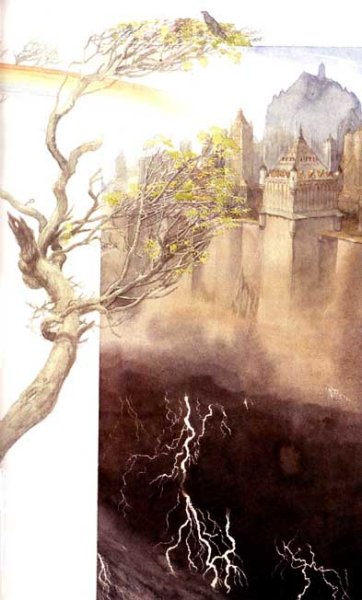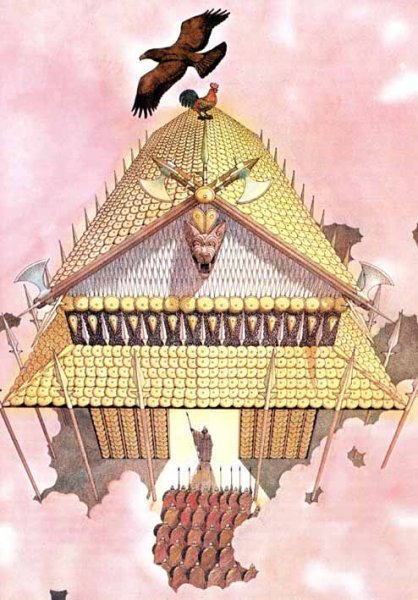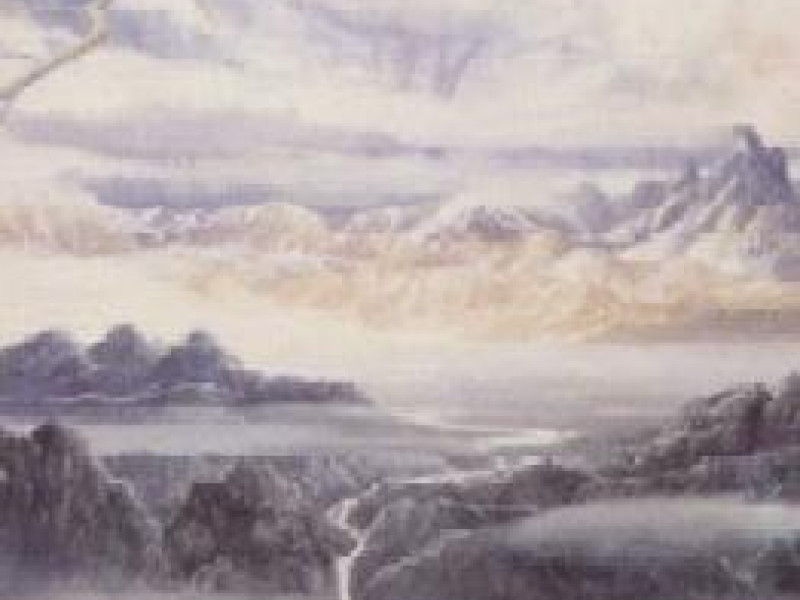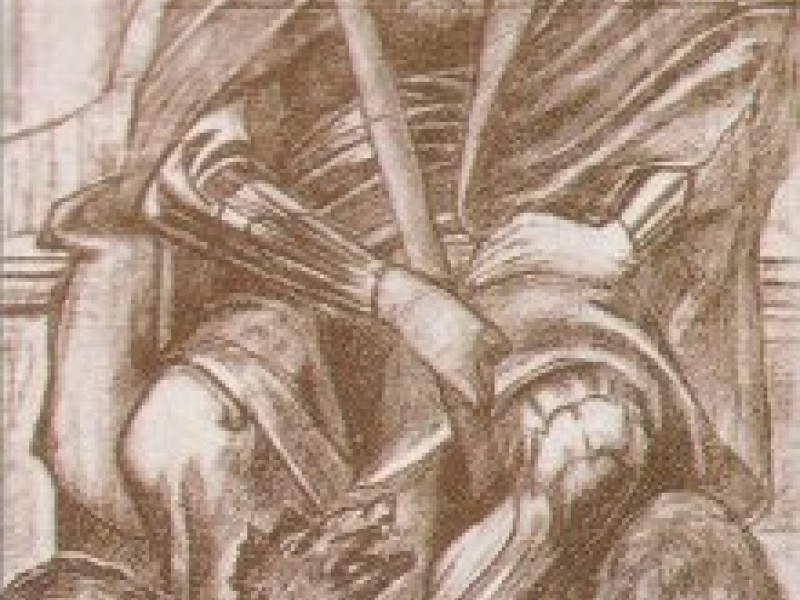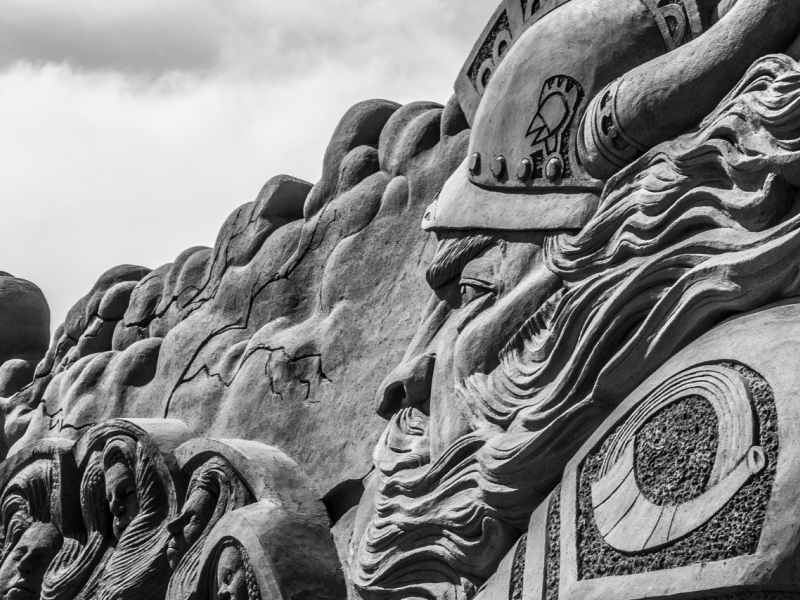Norse Creation

Creation
The Creation as seen in Norse mythology was strange and different from that of classical Greek mythology. Yet it is nevertheless fascinating, because of the roles played by giants and the gods.
Ymir
There was nothing in the beginning but a seemingly almost endless chasm called the Ginnungagap. Ginnungagap was a void like the Greek Chaos. Ginnungagap was bordered by Niflheim, which was a place of darkness and ice, far to the north; and Muspelheim, a place of fire, far to the south. Out of this chaos, the first being came into existence from a drop of water when ice from Niflheim and fire from Muspelheim met.
This first being was Ymir, a primeval giant. The frost-giants called him Aurgelmir, but everyone else called him Ymir. Ymir became the father of a race of frost-giants.
Ymir was the father of a six-headed son who was nourished by a cosmic cow called Audumla. Audumla fed herself by licking a salty rime-stone until that stone was licked into a shape of a man. This stone-man was named Buri and he was the first primeval god. Buri was the father of Bor.
Bor married the giantess Bestla, the daughter of the frost-giant Boltha. And they became the parents of the first Aesir gods Odin, Vili (Hoenir) and Ve.
Ymir grew so large and so evil that the three gods killed Ymir. The blood that flowed from Ymir's wound was so great that almost all of the frost giants drowned in the torrent. Only the frost giants Bergelmer and his wife escaped the flood in a chest, arriving on the mountain of Jötunheim (Jotunheim) which became the home of the giants.
Yggdrasill and the Nine Worlds
Odin and his brothers then used Ymir's body to create the universe. This universe was comprised of nine worlds. They placed the body over the void called Ginnungagap.
They used his flesh for creating the earth and his blood for the sea. His skull, held up by four dwarves (Nordri, Sudri, Austri, and Vestri), was used to create the heavens. Then using sparks from Muspelheim, the gods created the sun, moon and stars, while Ymir's eyebrows were used to create a place where the human race could live in; a place called Midgard (Middle Earth).
A great ash tree called Yggdrasill ("World Tree") supported the universe, with roots that connected the nine worlds together. One root of Yggdrasill extended to Muspelheim ("world of fire"), while another root to Niflheim (the "world of cold" or "of ice"). Niflheim was sometimes confused with Niflhel; Niflhel being known by another name – Hel - was the world of the dead. Hel was sometimes used interchangeably with Niflhel by many writers as the world of the dead.
The name Yggdrasill means "Steed of Ygg". Ygg is another for Odin, which means "Terrible One". Therefore, the great tree means in English, "Steed of the Terrible One". Odin's horse is named Sleipnir, but I found no connection between the tree and Sleipnir.
One root of Yggdrasill was connected to Asgard (home of the Aesir), and another root to Vanaheim (home of the Vanir). The frost giants lived Jötunheim (Jotunheim). Midgard was the world for humans. Alfheim was the home of the light elves (ljósálfar). There was also an underground world for the black elves (svartálfar), called Svartalfheim. The dwarves inhabited the world of Nidavellir.
Besides the three roots of Yggdrasill, there were three wells.
The Norns guarded the Urdarbrunnr, which is often known as "Weird's Well", "Wyrd's Well" or "Urda's Well". The Weird's Well was considered to be very holy. The Norns were Urda or Weird or Wyrd ("Past"), Verdandi ("Present") and Skuld ("Future"). Two swans drank from this well.
The Norns cared for the root near the Weird's Well. Every day, they took water from the holy well, pouring it on the root and soil, so that at least this root wouldn't rot or decay like the other roots. The mud was white in colour. This white mud caused honeydew to fall to the earth, keeping the valley around the well forever green.
Each day, the Aesir sat at the court at Weird's Well. Horses took the Aesir to this court. Odin rode Sleipnir. Ten other horses were given names: Glad, Gyllir, Glær, Skeidbrimir, Silfrtopp, Sinir, Gils, Falhofnir, Gulltopp (belonging to Heimdall) and Lettfet. Balder's horse was burned with him. Apart from Sleipnir and Gulltopp, no specific horses were assigned to a particular god. The Aesir had to ride across Bifrost (Rainbow Bridge) to reach Weird's Well.
Thor didn't bother to ride to attend the court. Thor walked and waded through the rivers, Kormat and Ormt and two Kerlaugs.
The second well was Mímisbrunnr (Mimisbrunnr) or the "Well of Mimir" which was also known as the "Well of Knowledge". The well was said to be guarded by the Aesir god named Mimir, a Norse god of wisdom. See the Well of Knowledge in the Search for Wisdom on how Odin paid Mimir to drink from this well.
The third well was called Hvergelmir or the "Roaring Kettle", where a giant serpent called Nidhogg continuously gnawed at the root of Niflheim. Eventually, Nidhogg would eat its way through the root, and that would cause Yggdrasill to collapse. But this wouldn't happen until Ragnarok finally arrived. Nidhogg also liked sucking on the bodies of the dead.
There were many other animals that dwelled around Yggdrasill. Apart from Nidhogg, there were countless snakes living with the great serpent. From above, four harts or stags fed on the foliage. The harts were given the names of Dain, Duneyr, Durathror and Dvalin. So with Nidhogg feeding on one root from above, the stags also fed from above, while the side of the tree rotted. Yggdrasill suffered greatly.
Perched on one of the branches was a great eagle, wise beyond its years. A hawk called Vedrfolnir sat between the eyes of the eagle. Not only that, there was a squirrel called Ratatosk who seemed to enjoy running up and down the great ash tree, delivering malicious messages between the eagle from above and Nidhogg below.
See the article on Asgard for more description of Asgard, the home of the Aesir.
Related Information
Sources
Voluspa ("Sibyl's Prophecy") from the Poetic Edda.
Vafthrudnismal ("Vafthrudnir's Sayings") from the Poetic Edda.
Grimismal ("Grimnir's Sayings") from the Poetic Edda.
Gylfaginning, from the Prose Edda, written by Snorri Sturluson.
Name
Yggdrasill – "Steed of the Terrible One".
Nine Worlds
Niflheim - ice
Muspelheim - fire
Asgard - Aesir
Vanaheim - Vanir
Jötunheim - giants
Midgard - mankind
Alfheim - elves
Svartalfheim - black elves
Nidavellir - dwarves
Wells of Yggdrasill
Urdarbrunnr – "Well of Urda"
"Well of Fate".
Mímisbrunnr – "Well of Mimir"
"Well of Knowledge".
Hvergelmir – "Roaring Kettle"
Contents
Related Pages
Fact and Figures
By Jimmy Joe

